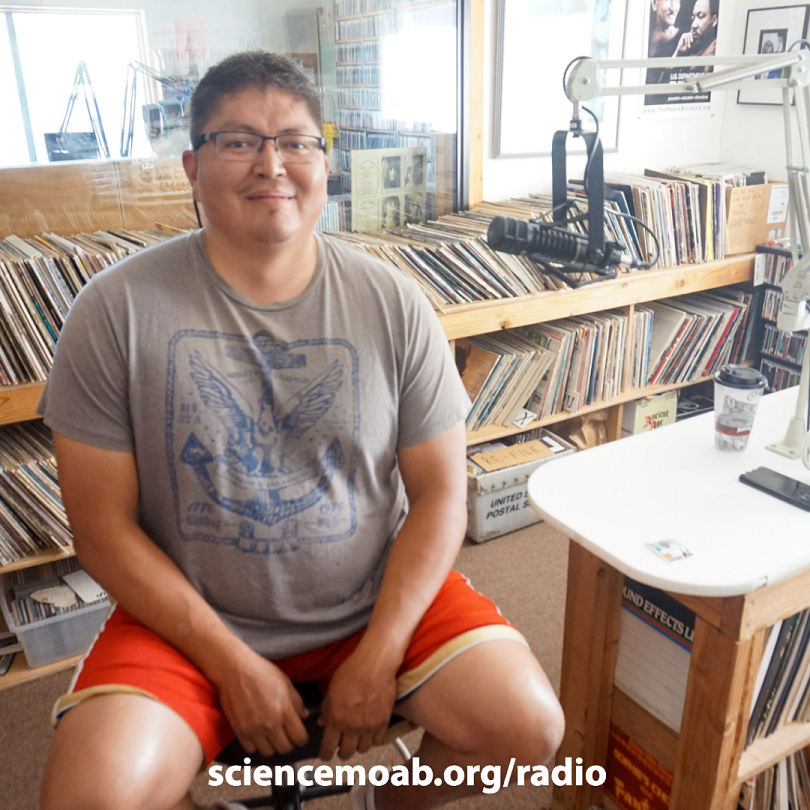The Colorado Plateau has a long history of uranium mining, particularly within the Navajo Nation. Hundreds of abandoned uranium mines still contaminate water sources and ecologies within the Nation, creating dangerous levels of exposure within tribal communities. Science Moab spoke with Dr. Tommy Rock, an environmental scientist who has testified before Congress as a leading expert in uranium contamination on the Navajo Nation, about his work to uncover these exposure pathways while empowering his community.
Science Moab: Can you explain the history of uranium mining within the Navajo Nation?
Rock: The mining actually first started with people looking for vanadium. [A chemical element primarily used as an additive to steel. -ed.] People flocked to the Four Corners area looking for it. Uranium mining started around 1918, but really started booming in the 1950s and ‘60s when the atomic bomb happened and the Cold War began.
Science Moab: How many mines are in this area from that historic mining era?
Rock: On the Navajo Nation, there are over 1,000 individual abandoned uranium mines. On the Environmental Protection Agency side, that’s 523 abandoned “mine domains” as they typically group mines in one area and count them as one site. Many of the mines out there aren’t even documented.
Science Moab: How close are these old mines to people living in that region?
Rock: It all depends on the region and the location. Some of them are pretty close to communities like in Cameron, Church Rock, and Monument Valley. There are meetings about cleanup, which involve the tribes and federal agencies coming together and trying to understand what’s going on with these old sites. The Department of Energy has involved the Nuclear Regulatory Commission, the Bureau of Indian Affairs, and the Centers for Disease Control. These federal agencies and the tribes are all working together to address the mining remains on the Navajo Nation, each playing a role at different stages, especially when it comes to environmental health, public health and exposure from uranium mines.
Science Moab: How do the remains of these mines radiate and cause pathways of exposure to people and other living things?
Rock: The pathways of exposure include water, plants and animals. Some of the research coming out of Northern Arizona University studies the tissues of sheep from the Cameron area, comparing them with sheep from outside the reservation and away from the uranium mines. The studies show that there are elevated uranium levels in some of these tissues. But when it comes to the maximum contaminant level in each of these tissues, there’s still work that needs to be done to determine what the normal level is and whether or not the toxicity level of each tissue is safe or not.
Science Moab: Can you explain a bit more about the pathway of exposure through water?
Rock: Water seems to be the most common pathway of exposure. Many community members who live in rural areas live the traditional way of life. They don’t have running water. At times, they have to go to unregulated water sources like windmill hand pumps or springs. Often, the water quality of those unregulated sources is not looked at. Some of those waters have elevated levels of uranium that exceed the safe levels for human consumption from the Safe Drinking Water Act. In addition to uranium, we are also seeing large levels of arsenic.
Science Moab: Have these pathways of exposure been evident in human health outcomes?
Rock: I believe so. Some of the committee members that live near these wells will talk about their family members drinking from a certain water source, and they’ll talk about their family members who have passed away from cancer. When we sample the water, we see elevated levels of uranium in the drinking water source. People are becoming more aware of how heavy minerals can be related to health, which is really good.
Science Moab: What can be done to help address these pathways of exposure to uranium and other toxic minerals?
Rock: I think a good way to start is by educating ourselves—not just indigenous communities, but the general public as well. In addition, we should join with allies to come together and develop policies around mine cleanup.
To learn more and listen to the rest of Tommy Rock’s interview, visit soundcloud.com/user-495802209/pathways-of-exposure-the-legacy-of-uranium-mining-within-the-navajo-nation. This interview has been edited for clarity.
Science Moab talks to Dr. Tommy Rock about uranium exposure on the Navajo Nation




